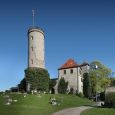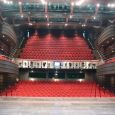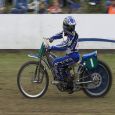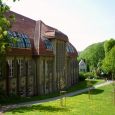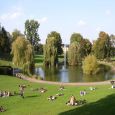Bielefeld
Advertisement
By Air
The nearest international airport is the airport Paderborn / Lippstadt, located in southwest 45 km from Bielefeld and accessible via the A 33. In the south of the city in the Senne district lies in the immediate vicinity of the B 68 and A 2 of the airfield Bielefeld. He has a 1256 m long, paved airstrip and a start line for gliding.The airport is used for business aviation, as well as by several aero clubs.
By Train
Bielefeld lies on the electrified main line Cologne - Dortmund - Hannover (four-track railway line Hamm-Minden) of the former Cologne-Minden Railway Company. In the district Schildesche crossed the line on the northern viaduct in Germany (Schildescher viaduct), the valley of St. John's Bach. The course meets in wages on the international railway route to Amsterdam (railway wages-Rheine, siding from Herford). On a side track branches off to the station or Lemgo Altenbeken (former railway line from Bielefeld to Hamelin "Begatalbahn") from. At the station Brackwede single-track branch lines branch off towards Osnabrück (Osnabrück-Bielefeld railway "Haller Willem") and Paderborn ("Senne-Bahn" on Hövelhof) from. In the urban area there are eleven stations or stops.
By Bus
Brackwede at the station there is an international bus station for long distance bus services particularly to Eastern Europe (Poland, Baltic states), but also Western and Southern Europe. Long-distance buses to stop at Berlin Hauptbahnhof.Public transport use four light rail lines, regional trains and buses. The city of Bielefeld railway runs underground in the downtown area. All trams stop at the train station and subway stations and at Town Hall Square Jahn. On weekends (Fri / Sat, Sat / Sun) and night before public holidays buses on a particular night and early transportation network (Sundays until 8:30 clock). In all suburban trains, regional trains and buses (except night buses) is the "six-tariff" of OWL Verkehr GmbH.
By Bicycle
Bielefeld is a member of the Working Group bicycle-friendly cities and towns in North Rhine-Westphalia. At the main station, a bicycle station located with parking, a bike workshop and sales center and an office of the General German Bicycle Club.
By Road
Through the city of Bielefeld lead the federal motorways A2 and A33 as well as the Federal Road B 61, B 66 and B 68, the latter being expected with the completion of the A 33 in Bielefeld will no longer be dedicated as a highway.Should have been planned in the 1950s for the main routes towards Gutersloh, Herford, Lippe Werther and efficient roads, some of which use existing roads and partly run on new routes.The new pieces were provided largely free of cultivation.
Sparrenberg Castle
is a restored fortress in the Bielefeld-Mitte district of Bielefeld, Germany.It is situated on the Sparrenberg (180 m/591 ft altitude) in the Teutoburg Forest and towers 60 m (197 ft) above the city centre. Its current appearance mainly originated in the 16th and 19th century.The Sparrenburg is considered to be Bielefeld's landmark.The new counts of Ravensberg and the owners of the Sparrenburg, the dukes of Cleves, ordered the expansion of the castle, dictating that it should be adjusted in order to withstand the more effective siege guns.In the middle of the 15th century, a round bastion was added in the west, only accessible from the castle itself via a bridge, from which one could control Bielefeld Pass with artillery.
Bielefeld Opera
is the venue of Städtische Bühnen Bielefeld (Municipal Theatre Bielefeld) in Bielefeld, Germany. It is a Dreisparten Haus (three-department house), offering plays, music (opera, musical theatre), and ballet. The main performance venue is the Stadttheater am Niederwall (Municipal Theatre at the Lower Wall), built in 1904 and extensively renovated from 2004 to 2006. It is the largest theater in East Westphalia, offering 500 performances annually. It is under the direction of Michael Heicks; its resident orchestra is the 72-member Bielefeld Philharmonic Orchestra that also performs symphonic concerts at the Rudolf-Oetker-Halle.Between 1975 and 1998, under Director Heiner Bruns and dramaturge Alexander Gruber, the Bielefeld Opera became internationally renowned as the Bielefelder Opernwunder ("Bielefeld Opera miracle"), producing a series of successful rediscoveries and premiere performances. The team, which included John Dew as stage director, Gottfried Pilz as stage designer; Rainer Koch, David de Villiers, and Geoffrey Moull as conductors, helped Bielefeld Opera attract attention of the national German and British press; critics from Gramophone, the Financial Times, and New York (Opera News) became regular visitors.
Historical Museum of Bielefeld
The Historical Museum traces the history of the city of Bielefeld, and the region of East Westphalia-Lippe, with a focus on industrial history.It was opened in May 1994.The exhibition is in some halls of the former Ravensberg spinning mill located, making it the visitor into the atmosphere of industrialization plunges.In 1995 the museum received for its exemplary display of power and steam engines as the world's best representation of industrialization and its social history as the first European museum of the Dibner Award.The of the Society for the History of Technology (SHOT) prize, awarded after the American industrialist and art historian Bern Dibner named.
Natural History Museum Bielefeld
is a museum in North Rhine-Westphalian city of Bielefeld . Since 2003 it operates namu with the addition of terms for the Na ture, PEOPLE, ENVIRONMENT, and thus for an interdisciplinary study of ecology and economics is. This term is interpreted as a museum in the city Short for turkunde Na-Mu.In 2003, the museum is a new logo and the name was namu. The following years were determined by spatial and textual changes. It made the renovation and reconstruction of the mirror's court (2003 and 2004), the 100-year anniversary and the installation of the "natural history journey through time with the light rail" (2006), the opening of the new permanent exhibition "extinction - survival," the award of the association with the Environmental Prize of the City of Bielefeld and the rebuilding and renovation of the "branch of the namu", the "green house" at the Sparrenburg (2007), and the expansion of the museum's educational resources to 800 lots (2010).
Farmhouse Museum Bielefeld
is a museum in the East Westphalian city of Bielefeld in the Teutoburg Forest and the oldest open-air museum of Westphalia.It was opened in 1917 by the Historical Society of the County of Ravensberg .On the night of 22 to 23 May 1995 the main house the 17th- Meier-century court to Ummeln (mined in Ummeln 1915) completely destroyed by fire.Subsequently the court was made Mollering Rodinghausen a village in neighboring district of Herford built. It is a three-column home from 1590.The construction was completed in 1999.Since its reopening in the farmhouse museum of rural life is presented in 1850. 2001 it was European Museum of the Year.Built in the museum, the main house (1590), a bakery (1764), a Spieker (1807), a Bokemuhle (1826), a windmill (1686), a barn (1807), a bee house (1900) and a children's home. There is also a rural home garden and a vegetable garden and an orchard.Meals are available in the cafe of the museum.
Honky Tonk Festival
is an annually recurring musical event which is available in over 50 cities in Germany , Austria and Switzerland.You pay it at the time admission and can celebrate the event in all participating pubs, clubs and bars.The event is jointly promoted and usually performed with a program such as open-air stages, shuttle buses and road events.The focus of the conference is live music.The "artist mark" are spared. Honky Tonk is a registered trademark. Organizers of this festival is the blues Agency GmbH, the managing director Dominik Brahler. The event concept found many imitators, the events with the same character to perform under different names.The first German Honky Tonk found in 1993 in Schweinfurt place.The event concept quickly spread to other large and medium cities, as it has over individual concerts a greater pull on the audience and resulted from the collaboration with local pubs synergy effects and advertising opportunities on site.The first in Schweinfurt Headquartered organizer Blues Agency has been headquartered in Leipzig.
February - May
September - November


